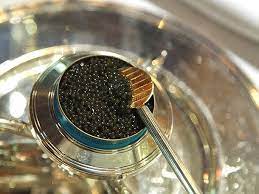I am half Japanese American and salty preserved products of fish are in my blood. I grew eating tarako – the salted and cured roe from Alaskan pollock – either grilled or served in rice onigiri. It wasn’t until after I began working in fancy restaurants that I tasted caviar for the first time. The first thing I tried was a tiny dollop (about a teaspoon) of Iranian ossetra, which I ate from a plastic spoon that the chef gave me in the walk-in fridge. The taste was subtle, with a mineral-like aroma and a slight saltiness. The sturgeon-roe beads rolled along my tongue and popped against my roof of mouth in small saline bursts. It was a mind-blowing experience, and I loved every chance to taste and work with the different varieties.
Advertisement Banner
Caviar, or salted roe, is the roe from a sturgeon. Sturgeons are a prehistoric fish with no scales that can be found in the Northern Hemisphere, from North America to China. You can also buy cured eggs of other fish, which are sometimes called caviar. However, the labeling always indicates the fish type, like “American spoonbill” or “Salmon”.
What was once largely wild-harvested is now mostly farm-raised. In the Soviet Union, wild caviar production and harvesting was a highly profitable and tightly controlled industry on the Caspian Sea and Black Sea. This all changed after the USSR disintegrated. Everyone wanted to get a piece. Overfishing sturgeons has had devastating effects on the ecosystem and industry. Since 2005, the United States Fish and Wildlife Service has banned the sale of Beluga Caviar–the most prized among the three most famous species of sturgeon. The wild ossetra sturgeon has also been harvested until it is near extinction. The caviar of this species is not available at the moment.
Most of the caviar sold in the U.S. today comes from fish farmed around the globe, with the United States, China and Israel among the top producers. What is the new market like and how can you be confident in your purchase?
Alexandre Petrossian (30), the third-generation Vice President of Petrossian spoke with us about the salted fish eggs. The famous Paris caviar company has an online shop, as well as a restaurant and a store in New York. He begins by saying that “they say a good caviar must have at least fifteen different flavors.” Each time you bite into a caviar, you should experience something new. The taste should be a long-lasting aftertaste that develops on your tongue.
He says that “surprisingly the Chinese farms are among the best.” Petrossian offers a variety of Chinese caviars, including Imperial Shassetra, Kaluga and Imperial Shassetra, the most expensive. They came to us even before they designed the farms to ask for specifics about the entire process and how our caviar should be harvested and raised. They were determined to get it right. The Chinese caviar, as a result, is one of the most consistent.
I brought five tins sturgeon caviar to Serious Eats World Headquarters, where we did a blind taste test. Prices ranged from $113 up to $481 for a 50-gram tin. Our favorites weren’t the most expensive.
Alexandre says that good caviar will have distinct, separate eggs when rolled on the roofs of your mouth. They should pop, not taste mushy. Caviar in a tin should sparkle, with each egg shining, and not be oily or murky. “Good caviar sparkles like diamonds,” says Alexandre. It’s difficult to photograph.
Caviar: How to Serve and Taste it
Champagne or vodka ice-cold are the traditional accompaniments for caviar. Alexander advises to avoid a heavy red or white wine when eating caviar. It will interfere with the taste.
I like to eat caviar right out of the tin with a spoon. The mother-of-pearl spoon is beautiful and traditional, but it’s not necessary to use one. Alex says, “I use a wooden caviar spoon because I learned to taste it that way as a child.” I prefer plastic spoons. Silver is the only material that should be avoided as it can react with caviar and give it a metallic taste.
If you’d like to add a bit more effort into your presentation, blini, boiled potatoes or toast are excellent backdrops. They will not only give the caviar some body but also won’t compete with its flavor. Also, chives and sour cream work well.
Once the caviar has been placed in your mouth, roll the eggs gently against your roof of mouth and breathe in through your nostrils to obtain the first aroma. After you have it, gently crush the eggs, feeling their contents pop on your soft palate. The primary flavor should be revealed. Try to identify as many flavors you can. Caviar is often described as buttery, rich and earthy. It can also be described as salty or fishy.
Finale, continue to inhale through your nose while swallowing the caviar to let its taste linger for as long as you can. Take a shot and rinse your mouth.
Caviar – Where to Buy it
It can be daunting to eat caviar. Here are 5 tips to ensure you get the most out of your caviar.
The More Expensive the Better
Even the cheapest sturgeon caviar is expensive. Expect to pay between $50 and $75 for 30 grams (1oz) of caviar, which is enough to feed two people. Prices can be astronomically expensive. Special Reserve Ossetra by Petrossian costs $12,000 per kilo or $378 per 30 gram tin.
Is paying more for caviar worth it?
“No, not at all,” says Alexandre. “The rarity of caviar determines its price, but it does not mean the rarer caviar will taste better for everyone.”
The size and texture (larger beads with a firmer texture that pops in your mouth) and the flavor of caviar are used to grade it. As a rule, milder flavored caviars are rarer. The final flavor can be greatly affected by the type of fish, its raising, and the way the caviar is treated and matured.
Just as with wine or whiskey, many tasters–even professionals–prefer the flavor and texture of less expensive, more common offerings, so long as they are tasted blind without knowledge of pricing.
Many tasters chose Petrossian Royal Transmontanus ($69/30g) over caviars that cost four times as much.
Begin with the lowest end
It is important to learn how to appreciate the subtlety of caviar. If you buy the most expensive caviar, the delicate flavors are likely to be lost on you. Your money will also have been wasted.
It is better to begin with a high-quality, but relatively cheap, caviar. You should taste it very carefully to determine what you like. You may like a rich buttery flavor or a nutty taste. Perhaps you prefer a stronger fishiness and salinity? You’ll have a better understanding of your preferences once you answer these questions.
Shop somewhere else if they won’t let customers taste the product.
Caviar is expensive, so you should always taste it before buying. Why would you buy $125 worth of shoes before trying them on?
Even when the caviars are from the same farm, they can differ from one batch to another. Past performance is not an accurate indicator of future results. Alexandre recommends that you go one step further and insist on tasting caviar straight from the tin. Unscrupulous caviar sellers will swap out a tin with substandard or dry caviar.
Buy enough
First-time caviar eaters are often hesitant to try more than a small amount, even if they know the value. Alexandre says that it is impossible to taste the caviar this way. You must roll enough caviar on your tongue in order to fully appreciate the aroma and texture.
A 30 gram tin is the minimum amount you should purchase for two people. These cute little 10g tins are tempting, and their low price makes it even more appealing. However, unless you intend to taste them by yourself or have only a few bites, these tins are useless.
Caviar online and on the black market: Beware!
This one is a no-brainer, given rule 3. You cannot guarantee the quality of caviar that you have not tasted yourself. Buying online is a sure way to receive a substandard product. You should only buy caviar online from a source that is known for its quality. Dean & Deluca is a good place to start, as are Russ & Daughters and Petrossian.
“With caviar if the price is too good to believe, it probably is,” says Alexandre. Black market caviar is no different. There’s no guarantee, no responsibility for substandard product and, worse, for some, there’s no accountability for environmental damage caused by illegal poaching.
6: Buy only what you need, and eat as fast as possible
Caviar, like a high-quality cured ham or cheese, is matured and cured by experts to maximize its flavor. It can change rapidly in quality once it’s sold and the tin has been opened. The eggs may soften, become stickier or more oily, and liquid will leak out of the tin. Keep the caviar in the refrigerator until you are ready to open the tin. This should happen within a couple of days after purchase. The caviar must be consumed within one day of opening.
Petrossian Boutique and Cafe
911 Seventh Ave New York NY 10019 (between the 57th and the 58th on the map); 212-245-2217, petrossian.com/
Featured Videos


